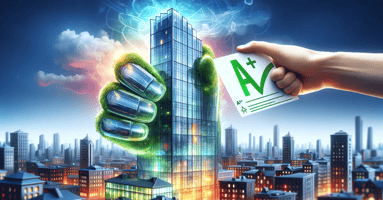We keep hearing that smart controls are revolutionizing buildings everywhere, making them more...
Smoke signals from your building
I want to show you something out my window today. You'd see this out of every single window out of every building in most major cities. There's always that tower at the top of a building and there's smoke coming out of it. What the heck is this thing and why is it so critical to the carbon footprint of buildings today?
Smoke stacks originated from burning coal to heat buildings.
Well, that tower where the smoke is coming out of is known as the stack and it's connected to the building's heating system. Every time you're seeing a building with smoke coming out of it, what you're seeing is the heating system running and oil or gas being burned to heat that building.
"Smart controls bring such an improvement to carbon emissions, local utilities will even pay you to use them.
A hundred years ago, buildings used to burn coal in their boilers. Coal was really gross and would create black, sooty smoke. Not only was that incredibly densely packed with carbon, but it also left a black residue all over the city. And not only on buildings, but on people, cars, streets, everywhere. It was gross.
Today, boilers burn much cleaner using oil or natural gas.
Over the last hundred years, things have gotten a lot cleaner. Most buildings have switched to either oil or gas. Originally, buildings used to use number six oil. Number six oil was really, really dirty. Over time, they've switched to four and now cities are mandating two oil. Number two is the cleanest burning of all the oils. But even cleaner than oil is gas. In fact, most buildings have switched to burning clean natural gas.

Even with cleaner boilers, smart controls further improve them 15% to 30%.
Yes, gas still produces smoke, but that smoke is a lot cleaner and contains less carbon emissions. However, we can make cities even cleaner by now reducing the amount that that boiler runs, and that's exactly what smart controls do.
Buildings that have upgraded smart controls will actually run their boiler between 15% and 30% less, which means 15% to 30% less oil or gas is being burned, and 15% to 30% less smoke and carbon emissions are being emitted from buildings.
Local utilities incentivize the use of smart controls.
Because smart controls make such an impact on improving energy efficiency and reducing carbon emissions, most local utilities have large funds set aside to pay for them to be installed. Use the form below to see if your building is eligible.
So next time you're walking by your building in the middle of winter and you see a giant cloud of smoke coming out of it, you should ask whether your building is using a smart control. Not only will your building be saving 15-30% on its energy bills, but it'll also be making your neighborhood and your city a cleaner and greener place to live and work.




